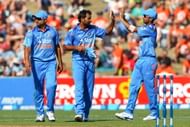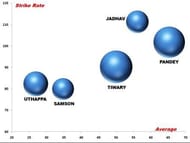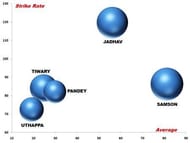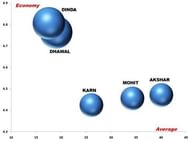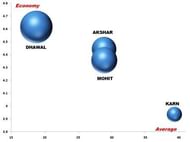Move on. No two words sum up the Board of Control for Cricket in India (BCCI) mindset better when it came to choosing the 30-man preliminary squad for the looming ODI World Cup. The first cut includes just four survivors from the 2011 World Cup winning team – MS Dhoni, Virat Kohli, Suresh Raina and Ravichandran Ashwin. Reactions have been sharply divided. While fans of ignored demi-gods like Yuvraj Singh, Virender Sehwag, Gautam Gambhir, Harbhajan Singh and Zaheer Khan have staged vehement protests across available social media forums, the higher echelons of cricket connoisseurs have leaned in favour of preferring youth over underprepared experience.
While some have hailed the BCCI’s move as brave, a closer look would indicate that the omission of these big names was somewhat of a no-brainer. Zaheer has not played List A cricket for the past two years, with limited match practice across other formats as well. Harbhajan, whose mediocrity in the 2011 WC was adequately masked by Yuvraj, is hardly a strike bowler even in domestic matches this season. Sehwag and Gambhir average in the 20s in List A cricket since the 2012-13 season, with slightly better returns in the IPL, which should not be an influencing factor in this selection. Over the same period, Yuvraj has racked up acceptable numbers, but a poor domestic season this year probably shut the doors on him.
Now that we have dwelt on the ‘elephant in the room’ awhile, let us turn our attention to the 30-man list, as segmented by ESPNCricinfo.
The highlighted names are those I believe to be absolute certainties in the 15-man squad which needs to be declared within the January 7 deadline set by the ICC.
Batsmen
Shikhar Dhawan, Rohit Sharma, Ajinkya Rahane, Virat Kohli, Suresh Raina, Ambati Rayudu, Kedar Jadhav, Manoj Tiwary, Manish Pandey, M Vijay
Fast Bowlers
Ishant Sharma, Bhuvneshwar Kumar, Mohammed Shami, Umesh Yadav, Varun Aaron, Dhawal Kulkarni, Stuart Binny, Mohit Sharma, Ashok Dinda
Spinners
R Ashwin, Parvez Rasool, Karn Sharma, Amit Mishra, Ravindra Jadeja, Akshar Patel, Kuldeep Yadav
Wicketkeepers
MS Dhoni, Robin Uthappa, Sanju Samson, Wriddhiman Saha.
As expected, India’s batting line-up is well settled, and barring major injuries, the top six batsmen and Dhoni select themselves.
Moving on to the quick bowlers, Shami and Umesh have been India’s best bowlers this year (both averaging about 22 in 2014) and should surely be in the 15. I can sense a few eyebrows being raised at Bhuvneshwar’s name not being highlighted; will get to that in due course.
I have not highlighted any spinners, as both of India’s frontline tweakers, Ashwin and Jadeja, have had a mediocre year. Youngsters like Akshar and Karn are knocking at the door, and no senior can take their place for granted, bearing in mind the message given out by the board at the onset.
India went into the 2011 WC without a reserve keeper, but they may think otherwise this time around, given that Dhoni is older and more injury-prone than four years ago.
Predicting the 15-man squad
In the exercise that follows, I have attempted to narrow down to the 15-man squad using a combination of objective and subjective analysis. With nine men already decided, for me at least, the actual task would be to select six more from the remaining 21.
Big names like Ishant, Bhuvneshwar, Aaron, Ashwin and Jadeja have not been considered for objective analysis, which focuses predominantly on the relative newcomers to ascertain their current form. The List A tournaments considered for this analysis are - Quadrangular A-Team One-Day Series 2014, Vijay Hazare Trophy (VHT), 2014/15, and Deodhar Trophy (DT), 2014/15. I have, however, taken the liberty of eliminating a few subjectively, based on their no-shows in the aforementioned tournaments.
According to unconfirmed reports, Vijay barely edged out Yuvraj, as the think-tank believes that he could be a better man to have around, in case he strikes form during the ongoing Test series in Australia. Vijay has not created an impact in any of the List A tournaments selected for analysis, and neither do his past ODI exploits generate confidence. I do not see him making the next cut unless he performs extraordinarily, or one/both of the regular ODI openers fail miserably, in the Test series.
Binny has been in and out of the Indian team, and his dibbly-dobblers, largely ineffective even in English conditions which support his ilk of medium pacers, will be largely relegated to hit-me-stuff on Australian pitches.
Rasool, Mishra and Kuldeep find themselves in the 30 on the back of consistent performances in domestic tournaments over a period of time, as well as the IPL, but should surely be the first to get culled when the next level selection is initiated.
Very much in the Vijay mold, Saha could get a look-in if he impresses during the ongoing Test series, but a relatively ho-hum List A season, and non-participation in the quadrangular, eliminate him from my analysis.
Bubble Analysis
For the drill-down, I have implemented a bubble analysis, which evaluates attributes across three parameters, and is, therefore, more comprehensive than two-dimensional ones.
The players to be analyzed are bucketed into two segments:
Batsmen: Jadhav, Tiwary, Pandey, Uthappa, Samson
Bowlers: Dhawal, Mohit, Dinda, Karn, Akshar (Ishant, Bhuvneshwar, Aaron, Ashwin and Jadeja are parked for subjective analysis and not a part of bubble analysis)
Determining the batsmen
For the batting analysis, the X-axis represents a batsman’s average, Y-axis his SR, and size of the bubble represents total runs scored, across the three tournaments. For the layman, the further away from the axis a particular batsman finds himself, the better it is as it indicates a higher average and SR. The sheer volume of runs scored is indicated by the bubble size.
Looking at the bubble analysis over all three tournaments (Fig 1a), Tiwary and Pandey make a very strong case for themselves, topping the run-scoring charts, with more than respectable averages and strike rates. Jadhav has scored the fastest, but his bubble (runs scored) is quite small. Samson and Uthappa appear to be the weakest in the fray. Based on an overall analysis, the battle looks to be very much between Tiwary and Pandey.
While overall form is a definite plus, I have assigned greater importance for the Quadrangular (Fig 1b), given that recent success or failure in conditions similar to where the World Cup will be played cannot be ignored. The equation changes quite a bit when the Quadrangular series is considered in isolation. Uthappa continues to languish at the bottom, however, and is the first to be eliminated.
Tiwary and Pandey, heavy scorers in the VHT and DT, average in the 20s in the Quadrangular. Both made 90+ in India A’s second match of the tournament, against South Africa A, which indicates that they did little else in the remainder of the tournament.
Samson and Jadhav were India’s top performers in the Quadrangular. Jadhav, not a part of the playing XI in initial games, first made an impact in the match against the National Performance Squad (NPS). Along with Samson, Jadhav’s 53-ball 87 rescued India A from 5-63 after James Muirhead and Sean Abbott (yes, him) ran through the top-order, and led the successful 235-run chase. His 73-ball 78 in the final was instrumental in India A emerging victorious in the keenly contested tournament.
Jadhav has played fewer matches than Tiwary and Pandey, having missed the VHT due to injury, which explains him scoring fewer runs. The fact that he was a part of the experimental squad during the recent ODI series between India and Sri Lanka, while the other two were not, is ample hint that he remains within the think-tank’s scheme of things.
Samson has been the standout performer in the Quadrangular, outscoring even Jadhav as the graph indicates, although failures in the VHT and DT have pulled him down in the overall analysis. Particularly impressive was his prowess as a finisher, especially in chases, where he was almost Bevan-like in guiding the team over the finish line, ending with a tournament average of 81.33.
In an eight-man batting shortlist (including Dhoni), only one of Samson and Jadhav looks likely to get through. It is extremely difficult to separate the two, and the question to be asked is – who between them is more likely to get into the XI? The immediate answer is, probably neither, but Samson’s ability to double up as a reliable keeper could win him the selectors’ nod, considering that it is highly risky to have a coming-off-injury Dhoni as the sole keeper over the course of the marquee tournament.
Therefore, Samson is the first and only addition to my batsmen’s list for the 15-man shortlist.
Determining the bowlers
There are five spots up for grabs here, in a bowling shortlist which should have five medium pacers and two spinners. With not more than one specialist spinner expected in the final XI, I do not see a point in carrying excess baggage in that department.
For the bowling analysis, the X-axis represents a bowler’s average, Y-axis his economy, and size of the bubble represents total wickets, across the three tournaments. For the layman, the closer to axes a particular bowler finds himself, the better it is, for it indicates lower average and economy. The volume of wickets captured is indicated by the bubble size.
Looking at the bubble analysis across all three tournaments(Fig 2a), among the seamers, Dhawal and Dinda are the strongest competitors. The biggest impediment to Dinda’s inclusion is that he was not picked for the Quadrangular(Fig 2b). The move indicates that the Bengal quick was not even in the selectors’ second-tier thoughts a few months back, but he forced his way there with a powerful showing in the VHT and DT. This has rewarded him with a place in the 30, but I do not think he will make it into the 15. Mohit has performed in spurts, with a decent Quadrangular series but not much more. Dhawal is, therefore, the strongest medium-pacer in this group and elevates him into the subjective analysis level where the completion gets stiffer.
For me, Bhuvneshwar is an overrated ODI bowler. His career ODI figures of 44 wickets in 42 matches at an average of nearly 37 are mediocre; he has been worse this year, picking only 14 wickets in 16 matches at an average in excess of 45. Bhuvneshwar continues to impress in Tests, but his ODI career has followed a disappointing pattern – tight opening spell speckled with gasp-inducing deliveries exhibiting exaggerated swing to beat the bat (in helpful conditions), followed by a lambasting at the death.
The largely inexperienced pace attack needs a moral spearhead though, one who might justify selection on the basis of ‘form is temporary, class is permanent’ adage. To be honest, Bhuvneshwar cannot boast of ‘permanent class’ in the ODI context, but he has been the leader, albeit unsuccessful of late, of the Indian attack in recent times, and it could upset the psychological apple-cart if he is dumped at this stage. Therefore, going against what I have been preaching for a while, Bhuvneshwar makes it to the team, on reputation alone.
Conditions in Australia are tailor-made for a hit-the-deck bowler like Ishant, which is why, in spite of an indifferent ODI season this year, the 6ft 4in (193 cm) paceman will be indispensable in the 15.
The fight for the final seamer’s slot should be between Aaron and Dhawal. There is very little data to analyze Aaron, with him not participating in any of the List A tournaments I have chosen for analysis. He made a brief and impressive appearance during the ODI series against Sri Lanka, but limped off after just four overs. He could come into reckoning if he holds up and bowls well during the ongoing Test series, but as of now, I have no reason to include him. Dhawal is, therefore, the final seamer in my shortlist.
Coming to the spinners, Akshar and Karn are closely matched. Owing to their increasing number of inclusions in the national team, both of them have not participated much in the domestic tournaments. A better VHT positions Karn as superior in the overall analysis, but Akshar beats him hands down in the Quadrangular. The tall left-arm slow orthodox bowler seals the deal by emerging as the highest wicket-taker in India’s recently concluded ODI series against Sri Lanka, which also featured an unimpressive Karn.
Both are useful batsmen down the order, but Akshar again takes the cake with a tighter technique and greater calm under crunch situations, best displayed during his unbeaten 38-ball 45 in the Quadrangular final which took India to an improbable victory over Australia A.
Both Jadeja and Ashwin have had a mediocre year with the ball, but the left-armer’s superiority in the batting department, in addition to the overwhelming confidence skipper Dhoni has in him, hold him in good stead for selection. Also, if India go in with a five bowler strategy, then Jadeja will be an absolute necessity in the XI. Therefore, of the two specialist spinner slots in the final 15, Jadeja gets the first.
Karn may stand an outside chance if he makes an impact in the second innings of the Adelaide Test. This could extend his immediate Test career and if he continues taking wickets, could tempt selectors to include the leg-spinner in the 15. As this is highly speculative, I turn the focus back on the remaining two contenders – Akshar and Ashwin. The biggest factor against Akshar is that in Jadeja, we already have a left-arm orthodox spinner in the 15. It might seem almost regressive to have two similar bowlers in an attack already lacking variety in the spin department. However, I think otherwise. Having followed Akshar closely over the past year, I believe that he has consistently excelled with both bat and ball in limited over formats, and on current form, is well ahead of Ashwin. I will, therefore, stick my neck out and pick him as the 15th member.
Here’s my final list, in the original format:
Batsmen
Shikhar Dhawan, Rohit Sharma, Ajinkya Rahane, Virat Kohli, Suresh Raina, Ambati Rayudu
Fast Bowlers
Ishant Sharma, Bhuvneshwar Kumar, Mohammed Shami, Umesh Yadav, Dhawal Kulkarni
Spinners
Ravindra Jadeja, Akshar Patel
Wicketkeepers
MS Dhoni, Sanju Samson
This equation could change on the basis of performances in the Test series, injuries, and/or gut feel of the powers that be. With the ICC deadline less than a week away, we will soon know.
The anticipation is palpable.
This article has been contributed by a member of the SK Featured Bloggers Club. It was originally published on 'Cricket Analytix’ blog here.
Brand-new app in a brand-new avatar! Download CricRocket for fast cricket scores, rocket flicks, super notifications and much more! 🚀☄️
